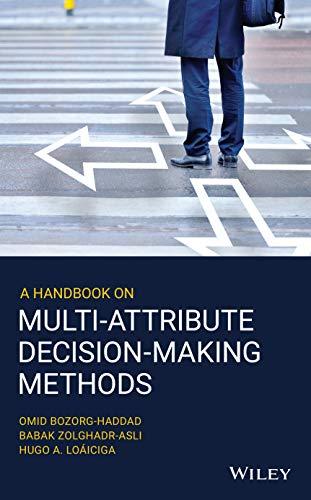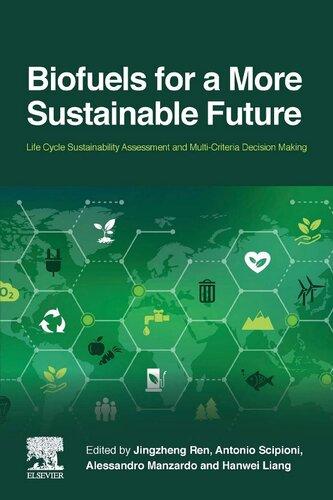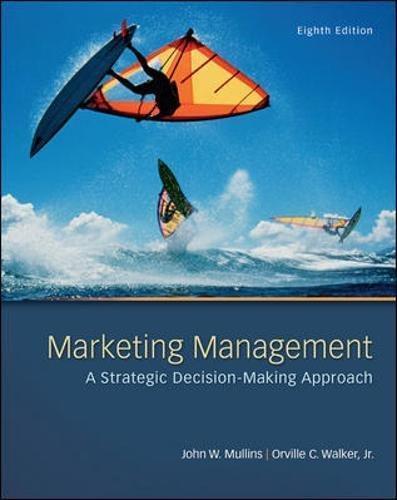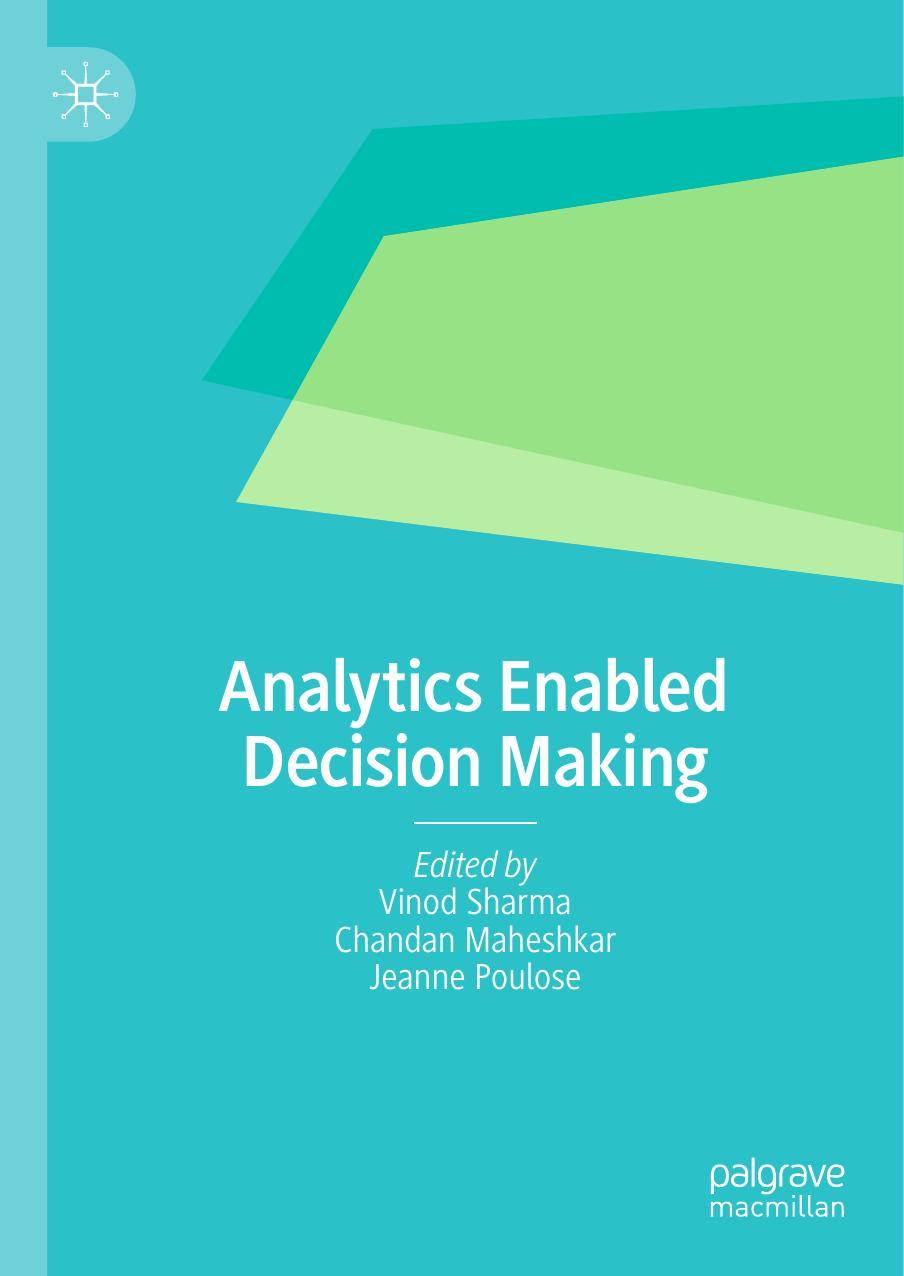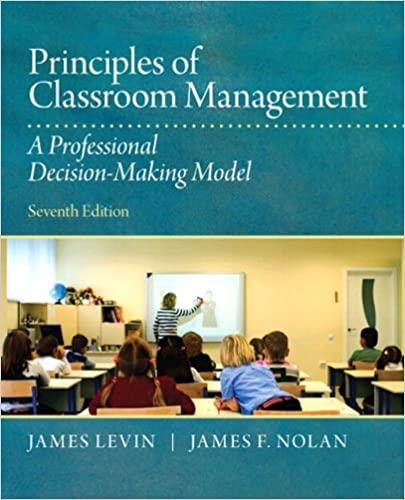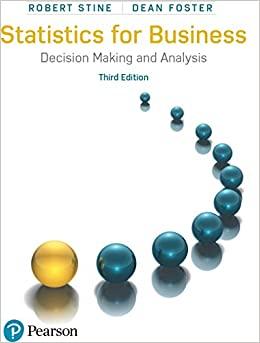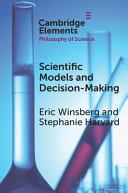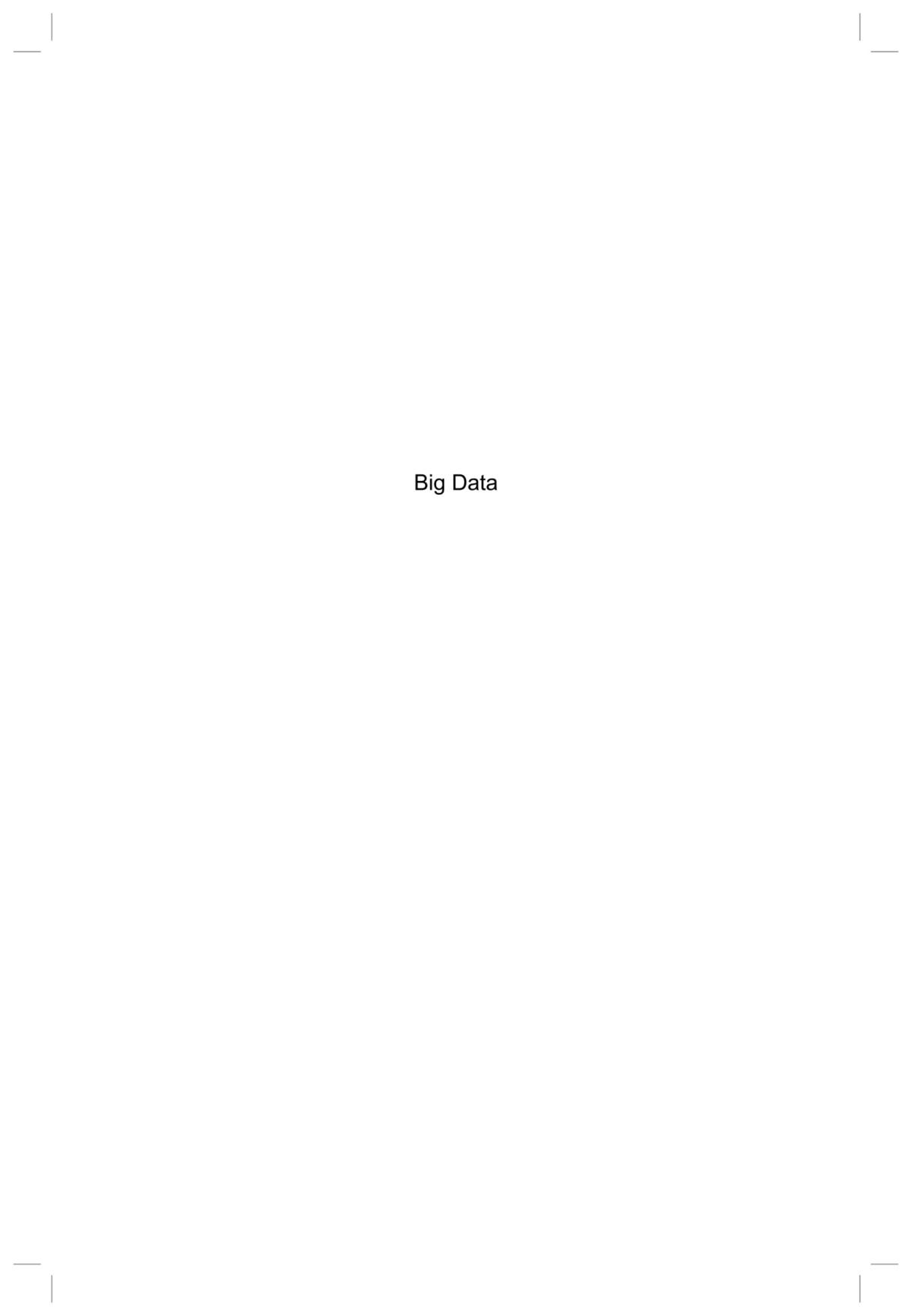AHandbookonMulti-Attribute
Decision-MakingMethods
OmidBozorg-Haddad
UniversityofTehran Alborz,Iran
BabakZolghadr-Asli
UniversityofTehran Alborz,Iran
HugoA.Loáiciga
UniversityofCalifornia SantaBarbara,UnitedStates
Thiseditionfirstpublished2021 ©2021JohnWileyandSons,Inc.
Allrightsreserved.Nopartofthispublicationmaybereproduced,storedinaretrievalsystem,or transmitted,inanyformorbyanymeans,electronic,mechanical,photocopying,recordingorotherwise, exceptaspermittedbylaw.Adviceonhowtoobtainpermissiontoreusematerialfromthistitleis availableathttp://www.wiley.com/go/permissions.
TherightofOmidBozorg-Haddad,BabakZolghadr-Asli,andHugoA.Loáicigatobeidentifiedasthe authorsofthisworkhasbeenassertedinaccordancewithlaw.
RegisteredOffice
JohnWiley&Sons,Inc.,111RiverStreet,Hoboken,NJ07030,USA
EditorialOffice 111RiverStreet,Hoboken,NJ07030,USA
Fordetailsofourglobaleditorialoffices,customerservices,andmoreinformationaboutWileyproducts visitusatwww.wiley.com.
Wileyalsopublishesitsbooksinavarietyofelectronicformatsandbyprint-on-demand.Somecontent thatappearsinstandardprintversionsofthisbookmaynotbeavailableinotherformats.
LimitofLiability/DisclaimerofWarranty
Whilethepublisherandauthorshaveusedtheirbesteffortsinpreparingthiswork,theymakeno representationsorwarrantieswithrespecttotheaccuracyorcompletenessofthecontentsofthiswork andspecificallydisclaimallwarranties,includingwithoutlimitationanyimpliedwarrantiesof merchantabilityorfitnessforaparticularpurpose.Nowarrantymaybecreatedorextendedbysales representatives,writtensalesmaterialsorpromotionalstatementsforthiswork.Thefactthatan organization,website,orproductisreferredtointhisworkasacitationand/orpotentialsourceoffurther informationdoesnotmeanthatthepublisherandauthorsendorsetheinformationorservicesthe organization,website,orproductmayprovideorrecommendationsitmaymake.Thisworkissoldwith theunderstandingthatthepublisherisnotengagedinrenderingprofessionalservices.Theadviceand strategiescontainedhereinmaynotbesuitableforyoursituation.Youshouldconsultwithaspecialist whereappropriate.Further,readersshouldbeawarethatwebsiteslistedinthisworkmayhavechangedor disappearedbetweenwhenthisworkwaswrittenandwhenitisread.Neitherthepublishernorauthors shallbeliableforanylossofprofitoranyothercommercialdamages,includingbutnotlimitedtospecial, incidental,consequential,orotherdamages.
LibraryofCongressCataloging-in-PublicationData
Names:Bozorg-Haddad,Omid,1974-author.|Zolghadr-Asli,Babak,author.| Loáiciga,HugoA.,author.
Title:Ahandbookonmulti-attributedecision-makingmethods/Omid Bozorg-Haddad,BabakZolghadr-Asli,HugoA.Loáiciga.
Description:Hoboken,NJ:Wiley,2021.|Series:Wileyseriesin operationsresearchandmanagementscience|Includesbibliographical referencesandindex.
Identifiers:LCCN2020034049(print)|LCCN2020034050(ebook)|ISBN 9781119563495(cloth)|ISBN9781119563471(adobepdf)|ISBN 9781119563389(epub)|ISBN9781119563501(obook)
Subjects:LCSH:Multiplecriteriadecisionmaking.
Classification:LCCT57.95.B692021(print)|LCCT57.95(ebook)|DDC 658.4/03–dc23
LCrecordavailableathttps://lccn.loc.gov/2020034049
LCebookrecordavailableathttps://lccn.loc.gov/2020034050
CoverDesign:Wiley
CoverImage:©connel/Shutterstock
Setin9.5/12.5ptSTIXTwoTextbySPiGlobal,Chennai,India
Contents
Preface xiii
1AnOverviewoftheArtofDecision-making 1
1.1Introduction 1
1.2ClassificationofMADMMethods 5
1.2.1PreferenceEvaluationMechanism 5
1.2.2Attributes’Interactions 7
1.2.3TheMathematicalNatureofAttributes’Values 8
1.2.3.1DeterministicVs.Nondeterministic 8
1.2.3.2FuzzyVs.Crisp 8
1.2.4NumberofInvolvedDecision-makers 8
1.3BriefChronicleofMADMMethods 9
1.4Conclusion 10 References 12
2SimpleWeightingMethods:WeightedSumandWeighted ProductMethods 17
2.1Introduction 17
2.2TheWeightedSumMethod 20
2.2.1Step1:DefiningtheDecision-makingProblem 20
2.2.2Step2:NormalizingtheElementsoftheDecision-matrix 21
2.2.3Step3:AggregatingthePreferenceofAlternatives 21
2.3TheWeightedProductMethod 21
2.4Conclusion 22 References 22
3AnalyticHierarchyProcess(AHP) 25
3.1Introduction 25
3.2TheHierarchicalStructure 27
3.3ThePairwiseComparison 30
3.4Inconsistency 33
3.5QuadrupleAxiomsoftheAHP 35
3.6StepwiseDescriptionoftheAHPMethod 36
3.6.1Step1:DefiningtheDecision-makingProblem 36
3.6.2Step2:PerformingthePairwiseComparisonThroughtheHierarchical Structure 37
3.6.3Step3:EstimatingthePreferenceValueVectors 37
3.6.4Step4:SynthesizingandComputingtheOverallPreferenceValueof Alternatives 38
3.6.5Step5:EvaluatingtheResults’RationalityandSelectingtheBest Alternative 38
3.7Conclusion 39 References 39
4AnalyticNetworkProcess(ANP) 43
4.1Introduction 43
4.2NetworkVs.HierarchyStructure 45
4.3StepwiseInstructiontotheANPMethod 48
4.3.1Step1:DefiningtheDecision-makingProblem 48
4.3.2Step2:ConductingaPairwiseComparisonoftheElementsofthe Decision-makingProblem 49
4.3.3Step3:FormingtheSupermatrix 52
4.3.4Step4:ComputingtheWeightedSupermatrix 53
4.3.5Step5:ComputingtheGlobalPriorityVectorsandChoosingtheMost SuitableAlternative 53
4.4Conclusion 54 References 54
5TheBest–WorstMethod(BWM) 59
5.1Introduction 59
5.2BasicPrinciplesoftheBWM 62
5.3StepwiseDescriptionoftheBWM 63
5.3.1Step1:DefiningtheDecision-MakingProblem 64
5.3.2Step2:DeterminingtheReferenceCriteria 64
5.3.3Step3:PairwiseComparisons 64
5.3.4Step4:ComputingtheOptimalWeights 65
5.3.5Step5:MeasuringtheInconsistencyofDecision-Makers Judgments 66
5.4Conclusion 67 References 67
6TOPSIS 71
6.1Introduction 71
6.2StepwiseDescriptionoftheTOPSISMethod 72
6.2.1Step1:EstablishingtheFormationoftheDecision-making Problem 73
6.2.2Step2:NormalizingtheElementoftheDecision-matrix 73
6.2.3Step3:ComputingtheWeightedNormalizedPreferenceValues 74
6.2.4Step4:DefiningtheReferenceAlternatives 74
6.2.5Step5:CalculationoftheSeparationMeasure 75
6.2.6Step6:ComputingtheRelativeClosenesstotheIdealSolution 76
6.2.7Step7:RankingtheAlternatives 76
6.3ACommonMisinterpretationofTOPSISResults 76
6.4Conclusion 77
References 78
7VIKOR 81
7.1Introduction 81
7.2StepwiseDescriptionoftheVIKORMethod 84
7.2.1Step1:ModelingtheDecision-MakingProblem 84
7.2.2Step2:NormalizingtheElementoftheDecision-Matrix 85
7.2.3Step3:Computethe“GroupSatisfaction”and“IndividualRegret” Parameters 85
7.2.4Step4:ComputingtheVIKORParameter 86
7.2.5Step5:RankingtheAlternatives 86
7.2.6Step6:DeterminingtheCompromiseSolution 86
7.3Conclusion 87
References 88
8ELECTRE 91
8.1Introduction 91
8.2ABriefHistoryoftheELECTREFamilyofMethods 93
8.3ELECTREI 94
8.4ELECTREII 96
8.5ELECTREIII 99
8.6ELECTREIV 104
8.7Conclusion 105
References 106
9PROMETHEE 111
9.1Introduction 111
9.2CommonGroundofthePROMETHEEFamily 112
x Contents
9.2.1Stage1:ConstructionoftheGeneralizedCriteria 113
9.2.2Stage2:MappingtheOutrankRelationontheSetofFeasible Alternatives 116
9.2.3Stage3:EvaluationtheRelationAmongtheFeasibleAlternatives 116
9.3PROMETHEEI 117
9.4PROMETHEEII 118
9.5PROMETHEEIII 119
9.6PROMETHEEIV 120
9.7Conclusion 121
References 121
10SuperiorityandInferiorityRanking(SIR) 125
10.1Introduction 125
10.2FoundationalBasesoftheSIRMethod 126
10.3StepwiseDescriptionoftheSIRMethod 129
10.3.1Step1:EstablishingtheFormationoftheDecision-Making Problem 129
10.3.2Step2:ComputingtheSuperiorityandInferiorityScores 129
10.3.3Step3:FormingtheSuperiorityandInferiorityMatrices 132
10.3.4Step4:SuperiorityandInferiorityFlows 133
10.3.5Step5:RankingtheSetofFeasibleAlternatives 135
10.4Conclusion 136
References 137
11PAPRIKA 139
11.1Introduction 139
11.2StepwiseDescriptionofPAPRIKA 140
11.2.1Step1:DefiningtheDecision-MakingProblem 141
11.2.2Step2:IdentifyingtheNondominatedPairsofAlternative 141
11.2.3Step3:RankingthePairsofNondominatedSolutions 142
11.2.4Step4:CalculatingtheCompleteRankingofAlternatives 144
11.3Conclusion 145
References 146
12GrayRelationalAnalysis 149
12.1Introduction 149
12.2GraySystemTheory:TheFoundationandBasicPrinciples 150
12.3GrayRelationalModeling 151
12.4GrayTheoryinRelationtoMADM 153
12.5Conclusion 155
References 155
AWeightAssignmentApproaches 159
A.1SubjectiveApproach:WeightedLeastSquares 160
A.2ObjectiveApproach:MultiobjectiveProgrammingModel 162
References 164
BABenchmarkExampleandaComparisonbetweenObjective-and Subjective-BasedMADMMethods 167
References 171
Index 173
Preface
Multi-attributedecision-making(MADM)problemsdescribeasituationinwhich thedecision-makersevaluateafinitenumberofpre-definedalternativesthat areexplicitlyknownatthebeginningofthesolutionprocesswithregardtoa setofoftenconflictiveevaluatingcriteria.Itwouldnotbeanexaggerationto statethatalmosteveryone,whetherintheirpersonalorprofessionallife,faces decision-makingproblemsonadailybasis.AlthoughtherearenumerousMADM methodsatthedecision-makers’disposaltocopewithreal-worlddecision-making problemsthereisstilllackingasourcethatcompilesandexplainsthevarious MADMmethodsinaclearandsystematicmannerthatwouldmaketheirunderstanding,comparison,andapplicationstraightforwardforthosewhorequire implementingthesetechniques.MostexistingsourcesthatdealwithMADM methodsaregenerallyfocusedonresultsoftheapplicationsofthesemethods,but overlookbasicandunifyingconcepts.Therefore,thosewhoareeagertogainan overviewofthesemethodsmustendurehardshipsofsearchingthroughvarious sourceswhicharewritteninspecializedformandaredifficulttounderstand.
Thebookathandfillsthecitedknowledgeandeducationalgapanddescribes themostimportantMADMmethods,withanassessmentoftheirperformancein solvingmultipleproblemsencompassingmanyfieldsofinquiryandpracticeina clearandsystematicmanner.Theproposedbookcontains12chaptersplustwo appendices.Chapter1providesanoverviewofthedecision-makinganditsfundamentalconcepts.Eachofchapters2through12isdevotedtoaseparateMADM method.Intotal,some20MADMmethodsarepresentedinthebook.Appendix Idescribesaweightassignmentmethod;AppendixIIcontainsanapplicationof MADMmethods.Thechaptersarearrangedbasedonpedagogicalpurposessothat theaudiencecaneasilyengagewiththepresentedmaterialsineachgivenchapter. Nevertheless,thebasicideaistoensurethateachchaptercanstandalonebyprovidingtheaudiencewithabriefdescriptionofthematerialsandmethodsrequired tocovereveryaspectandmathematicalconceptsusedineachgivenmethod.In otherwords,whileahighlyengagedaudiencecangothroughtheentirebookto
xiv Preface
gainadeepunderstandingofMADMmethodsandtheirtheoreticalfoundation, somecanaimataspecificchapterwithoutfacinganydifficultyinunderstandingthematerialspresentedforthereviewedMADMmethods.Inessence,each chapterdescribingaspecificMADMmethod,orinsomecaseafamilyofmethods,startswithabriefliteraturereviewofthemethods’developmentfollowed byadescriptionofitstheoreticalorigins.Thephilosophicalfoundationsofeach methodarediscussedandmappedtothemathematicalframeworkofthespecifiedMADMmethod.Eachchaptercontainsastepwisedescriptionofitspertinent methodthatservesastheguidelineforimplementingthemethodwiththepurpose ofcopingwithreal-worldMADMproblems.
February14,2021 IranandUSA
OmidBozorg-Haddad BabakZolghadr-Asli HugoA.Loáiciga
AnOverviewoftheArtofDecision-making
1.1Introduction
Whatmotivatesonetomakeadecision?Findingtheprecisereasonbehindthese motivationsmightnotbeaseasyasitmightseem.Nevertheless,giventhatthese choicesareshapingtheworldaroundus,itwouldnotbeanexaggerationtoclaim thattheanswertotheaforementionedquestionmayfacilitateunderstandingthe workingsofmanyworldphenomena.Justforamomentconsiderthepossibilityofknowingthemotivationspromptingpersontomakedecisions.Ifthatwere achieved,predictinghumans’behaviorfromthesimpleevery-dayactivitytothe mostsophisticatedsocial,economic,andpoliticalcontextswouldbepossible.
Nowletuschangethescopeofthequestion; howcanonemakeagoodchoice? Thistimewemaybemoresuccessfulinfindingamoreproperanswer.Letustakea momenttoconsiderthedescriptionoftheactofdecision-making.TheOxforddictionarydefinesdecision-makingas“theprocessofdecidingaboutsomethingimportant,especiallyinagroupofpeopleorinanorganization.”Fromapsychological pointofview,however,decision-makingisregardedasthecognitiveprocessresultingintheselectionofabelieforacourseofactionamongseveralalternativepossibilities.Eachdecision-makingprocessproducesafinalchoice,whichmayormay notpromptaction(TzengandHuang2011).Inotherwords,thedecision-making merelyreferstotheactchoosingamongasetofsolutions,ratherthantheproceduralrequirementsofexecutingtheselectedsetofalternatives.
Thedecision-makingprocessisfoundedonafour-stageanalyticalprocedure (VroomandJago1974;Belletal.1988;WeberandCoskunoglu1990;Kleindorferetal.1993).Thefirststageofthedecision-makingprocessisbetterknown asdescriptiveanalyticsorpositiveanalytics,whichisconcernedwithdescribing observedbehaviorsofthestakeholderswhoareinvolvedinthedecision-making process,mainlybylookingatthetheirpastperformanceandunderstandingsuch behavioreitherbymininghistoricaldatasets,and/orlookingforthebehavioral andsocial,psychological,andevenneurologyreasoningmotivationsthatcanbest
AHandbookonMulti-AttributeDecision-MakingMethods, FirstEdition. OmidBozorg-Haddad,BabakZolghadr-Asli,andHugoA.Loáiciga. ©2021JohnWiley&Sons,Inc.Published2021byJohnWiley&Sons,Inc.
1AnOverviewoftheArtofDecision-making
describethecourseofactionsmadebythestockholdersofthedecision-making problem(TzengandHuang2011;SantosandRosati2015).Descriptiveanalysisis outsidethescopeofthisbookinspiteofitspsychologicalnaturebeingpertinent todecision-makingprocess.
Thepredictiveanalyticstageconcernsthepredictionofwhatislikelytooccur givenasetofcircumstances,whichtakesplaceafterdiscerningthemotivational patternsbehinddecision-makingproblemsthroughdescriptiveanalyticaltechniques.Theapplicationofpredictiveanalysisislimitedtothedecision-making underuncertaintyand,admittedly,notalldecision-makingproblemsrequire suchapproach.Nevertheless,ifnecessary,thehistoricaldatasetsmaybereviewed duringthissecondstagetodeterminetheprobabilityofaneventorthelikelihood ofasituation’soccurrence(Belletal.1988;Kleindorferetal.1993).Exploringthis phaseofthedecision-makingprocessislefttoreadersgiventhescopeandaims ofthisbook.
Thethirdstageofthedecision-makingprocessisthenormativeanalysis.The term“normative”generallyreferstorelatinganitemtoanevaluativestandard throughassessingandmakingjudgmentsabouttheitem’sbehaviororoutcomes (KahnemanandTversky1984;TverskyandKahneman1986).Normativeanalysis, subsequently,isconcernedwithtechniquesthroughwhichthedecision-makers wouldbeabletoevaluatethefeasiblealternativesinamathematicalsense(Bell etal.1988;Kleindorferetal.1993).Notethattraditionalnormativeanalysis isbasedontheassumptionofrationalismthroughtheevolvedentitiesofthe decision-makingproblem,which,looselyspeaking,isatermthatrefersto decision-makerspursuingwhatwasdescribedthroughthepreviousstages,as theirinterestsandgoals.Naturally,makingadecisionirrationallyisbeyondthe scopeofthisbook,thoughmethodsareintroducedthroughoutthisbookthat wouldenabledecision-makerstocopewithdifferenttypesofcriteria,including intangiblecriteria.
Thefinalstageofthedecision-makingprocessiscalledprescriptiveanalysis.In thisstage,decision-makersgobeyondpredictingfutureoutcomestodetermine whichalternativeswouldbethemostadvantageousordesirablesolutionsto theproblemathand(Saad2001).Inotherwords,prescriptiveanalyticscombinetheinformationgatheredthroughstudyingthebehavioralpatternsofthe stockholders(descriptiveanalysis),thelikelihoodofrandomeventsinherentto thedecision-makingproblems(predictiveanalysis),whichwouldbeexpressed inmathematical-orientedframeworks(normativeanalysis),toobtainthebest courseofactionsforthedecision-makers.Furthermore,throughtherealms ofprescriptiveanalysis,decision-makerscanexplorethepossibleoptionson howtotakeadvantageoffutureopportunitiesorcopingwithfuturerisks,and, eventually,evaluatetheimplicationofeachfeasibledecisionoptionbasedonthe naturethedecision-makingproblemathand(Belletal.1988;Kleindorferetal. 1993;TzengandHuang2011).
Havingdefineddecision-making,weconsiderwhatisagoodchoiceoralternativeinadecision-makingproblem.Indeed,thenotionofa“goodalternative” maydifferamongdecision-makers’viewpointsduetotheirdifferentpersonal desires,experiences,andbackgrounds.Inotherwords,one’sideaofa“good choice”maynotnecessarilyrepresenteverydecision-makers’idealchoice. Furthermore,theselectionprocedureofdecision-makersmaydifferfromone another,whenfacingthesamedecision-makingproblem.Nevertheless,the decision-makers’selectionprocedureisfoundedonabasicandsimilarprinciple, whichisthatdecision-makerswouldhavetochooseasetofsolutionsthatwould outperformotherfeasiblealternativesbasedonasetofevaluationcriteriadefined eitherexplicitlyorimplicitlybythedecision-makersforthespecificproblemat hand.Infact,thisdecisionparadigmunderliesmulticriteriadecision-making (MCDM)ingeneral.Inpractice,almosteveryonemayfaceanMCDMproblem onadailybases,whichmostcopewithbyaggregatingthecriteriathrough anintuition-orientedweightingmechanism.Neverthelessimplementinga systematicMCDMapproachisessentialtomakinginformedandlogicaldecision.
Intechnicalterms,MCDMisaprocedurebywhichthedecision-makerexplicitly evaluatesasetofalternativeswithregardtomultiple,usuallyconflicting,criteria. DecisionmakersapplyMCDMstorestructureandredefinethedecision-making problemtomakeaninformeddecision.Althoughdevelopingandimplementing MCDMmethodsarenotnovelideas,therehavebeenundeniableadvancesinthis fieldsincethebloomingeraofcomputationalintelligence(CI)duringtheearly 1960and1970s,especiallyintheformofmathematicallyorientedmethodsthat recaptureandredefineMCDM.MCDMhasbeenanactiveareaofresearchthathas playedacrucialroleinanarrayofdisciplines,rangingfrompoliticsandbusiness totheenvironmentandenergy(Zolghadr-Aslietal.2018a).
HwangandYoon(1981)proposedclusteringMCDMproblemsbasedonthe natureofsolutionsthatareavailablefortheprobleminhandintotwomain categories,namely,multiobjectivedecision-making(MODM),andmultiattribute decision-making(MADM).Essentially,theaforementionedclassificationis basedonwhetherthesolutionsareexplicitlyorimplicitlydefined(Mendozaand Martins2006;TzengandHuang2011;VelasquezandHester2013).
MODMproblemsdescribeasituationinwhichdecision-makersaresearching forasetofsolutionsthatwouldsatisfytheconstraintsimposedonthegivenproblemandobtainresultsthatconstituteanoptimalsetofsolutionsbasedonthe decision-makersobjectives(HwangandYoon1981).Inessence,MODMissuitablefortacklingdesignandplanningproblems,inwhichthedecision-makersaim toachievestatesobjectivesorgoalsbyconsideringthevariousinteractionswithin thegivenconstraints.ThedecisionspaceofMODMproblemscanbedescribed asamultidimensionalCartesianspace,witheach(conflicting)objectiveacting asanaxis,definedbyasetofconstraintsthatseparatethefeasibleandinfeasible solutions.MODMcansolveproblemswithcontinuousordiscretedecisionspaces.
MODMsolutionmethodsareusuallyassociatedwithmathematicalprogramming methods(TzengandHuang2011).
Ingeneral,MODMinvolvetrade-offandscaleproblems(TzengandHuang 2011;Zolghadr-Aslietal.2018a).MODMinvolvesmorethanoneobjective, therefore,theoptimalsolutionstoaMODMproblemmustbeposedinterms ofParetofrontsorproductionpossibilityfrontier(aftertheItalianeconomist VilfredoPareto1848–1923),whicharesetsofpointsrepresentingcombinationsof thevaluesoftheobjectivefunctionswiththebesttradeoffsamongobjectivesthat areachievablefortheproblembeingsolved.InclassicMODMtechniques,an optimalsolutioniscommonlyobtainedwithmathematicalprogramming.This meansmultipleobjectivesaremergedintoasingle-objectiveproblemthrougha weightingofthevariousobjectives.Theprocessofobtainingaproperweighting schemefortheobjectivesisatrade-offproblem.Ifsuchtrade-offinformation isunavailable,Paretosolutionsmustbederived.ParetosolutionstoMODM problemsareexpressedasasetofnondominatedsolutions.Anondominated solutionhasthepropertythatitisnotpossibletoimprovethesolution’sutility ordegreeofpreferencewithoutdegradingatleastoneobjective(Zolghadr-Asli etal.2017,2018a).TheMODM’sscalingproblem,ontheotherhand,isacomputationalchallengesurroundingmostreal-world,practical,decision-making problems,wherebythestakeholdersmustconsiderseveralconflictingobjectives. Asthenumberofobjectivesincreasesthedecisionmakersface thecurseof dimensionality,wherebythecomputationalcostsofsolvingaMODMproblem becomeburdensomeintheextreme,andsometimescomputationallyunassailable(Bozorg-Haddadetal.2017;Zolghadr-Aslietal.2017,2018a).Inanattempt tosurmountthischallenge,meta-heuristicalgorithmshavearisentosearch withinthedecision-spaceandidentifypotentialsolutionstoaMODMproblem (Bozorg-Haddadetal.2017,Zolghadr-Aslietal.2018b,c,d).
MADMproblemsdescribeasituationinwhichthedecision-makersevaluatea finitenumberofpredefinedalternatives.Thealternativesareknownatthebeginningofthesolutionprocess.Thedecision-makersattempttosystematicallyassess eachalternativeviaadiscretepreferenceratingmechanism.Theratingmechanismusedbydecision-makerstoevaluateandcomparetheperformanceofeach ofthealternativesunderconsiderationisdefinedeitherexplicitlyorimplicitly (HwangandYoon1981).Table1.1comparesthemaincharacteristicofMCDM approaches,namely,MODMandMADM(Malczewski1999;MendozaandMartins2006;TzengandHuang2011;VelasquezandHester2013).
Nowadays,decision-makershavenumerousmethodsandtechniquesat theirdisposaltodealwithMCDMproblems,rangingfromsimple,easy-to-use approachestocomplextechniques.GiventheimportantroleofMADM,itis vitalfordecision-makerstoknowthemeritsanddrawbacksofMADMmethods. ThisbookintroducessomeofthefundamentalMADMmethodsthathavebeen
Table1.1 ComparisonofMODMandMADMapproaches.
CriteriaforcomparisonMODMMADM
CriteriadefinedObjectivesAttributes ObjectivedefinedExplicitlyImplicitly AttributesdefinedImplicitlyExplicitly ConstraintsdefinedExplicitlyImplicitly AlternativesdefinedImplicitlyExplicitly NumberofalternativesInfiniteFinite Decision-makers’controlSignificantLimited DecisionmodelingparadigmProcess-orientedOutcome-oriented RelevanttoDesign/operationEvaluation/choice
proventobeeffectiveandpracticalsolution-searchingtools.Section1.2describes thefoundationsofMADMmethodsandtheirclassification.
1.2ClassificationofMADMMethods
TherearenumerouswaysthroughwhichonecanclassifytheMADMmethods.A soundclassificationreliesonthecoreprinciplesandassumptionsofMADMtocategorizethesemethods.FamiliaritywithMADMmethodsisparamounttochoose adequatelyamongthemtosolveadecisionproblemathand.Accordingly,based onthedecision-makers’prioritizingsystem,theinteractionsamongattributes,the mathematicalnatureofattributes’values,andthenumberofdecision-makers, numerousclassificationshavebeenproposedforMADMmethods.
1.2.1PreferenceEvaluationMechanism
EveryMADMmethodrequiresapreferenceevaluationmechanismforthepurposeofreflectingthestockholders’preferencesinthedecision-makingprocess. Thesemechanismsactasameasurethatenablesdecision-makersevaluating alternativesaccordingtotheirattributes.Themechanismcanbedefinedeither explicitly(wherethepreferencevaluesarecomputablethroughasetofpredefined boundariesormathematicalfunctions),ortheycanbedefinedimplicitlysothat thedecision-makers’experiences,expertise,perception,andinstinctsarereflected inthealternatives’preferenceevaluation.
Aclassificationbasedonthenotionofpreferenceevaluationmechanismdivides MADMmethodsintomultiattributeutilitytheory(MAUT)andoutranking
1AnOverviewoftheArtofDecision-making
methods(BeltonandStewart2002;MendozaandMartins2006).Onthebasis ofBernoulli’sutilitytheoryMAUTmethodsobtainthedecision-makers’preferences,whichcanusuallyberepresentedasahierarchicalstructurebyusingan appropriateutilityfunction.Byevaluatingtheutilityfunctionthealternativewith thehighestutilityvaluecanbeidentifiedasthesolutiontotheMADMproblemat hand.InspiteoftheirrelianceofsolidaxiomaticbackgroundofMAUTmethods, theyarecriticizedbytheirunrealisticassumptionofpreferentialindependencies (TzengandHuang2011).Preferentialindependencedescribessituationsinwhich thepreferredoutcomeofonecriterionoveranotherisnotinfluencedbythe remainingcriteria.However,itsohappensthatthecriteriaareusuallyinteractive inreal-worldMADMproblems.Alternatively,insteadofbuildingcomplex utilityfunctions,outrankingmethodscomparethepreferencerelationsamong alternativestodetermineonthebestalternatives.Theoutrankingmethodswere introducedtoovercometheempiricaldifficultiesexperiencedwiththeutility functioninhandlingpracticalproblems.Yettheylackaxiomaticfoundation,such asisthecasewithclassicalaggregateproblemsandstructuralproblems(Tzeng andHuang2011).
ThepreviousclassificationcategorizesclassicalMADMmethods,yetitmay facedifficultiescategorizingsomeofthemodernMADMmethodswhosefeatures donotfiteitheroneofthepreviouslycitedcategories.BeltonandStewart(2002) proposedamoresophisticatedclassificationsystemforMADMmethodsthat addressesthelatterclassificationdifficulties.ThealternateclassificationcategorizestheMADMmethodswithinthreeclasses,namely,valuemeasurement,goal aspirationsorreferencelevel,andoutrankingmethods.Thisclassificationisa reviewednext.
Value-measurementMADMmethodsimplementnumericalscalestorepresent thedegreetowhichafeasiblealternativemaybepreferabletoanother.Thescores obtainedforeachalternativearedevelopedinitiallyforeachindividualevaluation criterionandarethensynthesizedtoratetheoverallperformanceofthealternatives.Thescoresassignedtoeachofthefeasiblealternativesreflectapreference order.Thesepreferencesmustbeconsistentwithasetofaxioms,whichareas follows(BeltonandStewart2002;MendozaandMartins2006):
(I)Constantdisciplineandrolesmustbeimposedbythedecision-makerinthe constructionprocedureofpreferencemeasurementscales;
(II)Provideaframeworkthroughwhichthedecision-makersareabletosystematicallyanalyzetheobtainedpreferencevaluesandgainadeeperunderstandingoftheprocessthatledtothefinalresults;and
(III)Promotingexplicitstatements,ratherthanimplicitjudgmentsregardingthe trade-offsbetweenevaluationcriteria.
Desirableorsatisfactorylevelsofachievementmustbedefinedbythe decision-makersforeachevaluationcriterion.Throughthesereferencelevel methods,thosealternativesthatareclosesttoachievingthegoalsoraspirations areidentified.ThesetypesofMADMmethodsarerecommendedforthose casesinwhichdecision-makersmaynotbeabletoexpresstrade-offsoridentify importanceweightsoftheevaluationcriteria.Nevertheless,themostdesirable outcomecanbeportrayedthrougharbitraryaspirationsorgoalsforeachcriterion. AsfarasthesebranchesofMADMisconcerned,analternativethatrepresents themostsimilaritieswiththearbitrarydefinedidealsolutioncanbestreflectthe stakeholders’interestsintheprocessofdecision-making.Throughtheframework representedbythisbranchofMADMmethods,thefeasiblealternatives,which areavailablecoursesofactions,aresystematicallyeliminateduntilachievinga solutionthatbestfitsthestakeholders’idealoutcomefortheMADMproblemat hand(BeltonandStewart2002;MendozaandMartins2006).
Lastly,outrankingMADMmethodsevaluatealternatives’relativeperformances againstoneanotherusingacomparison-orientedframework.OutrankingMADM methods,thefirstevaluatefeasiblealternativesbythedecision-makersinterms ofevaluationcriteriatoestablishtheirmerits.Thisisfollowedbyanaggregation stagewherebythegatheredinformationisusedasevidencetoobtainanalternative thatoutrankothersandemergesastheoptimalsolution.Theaggregationstage establishestherelationsbetweenthealternativesintermsofpreference,indifference,andincomparability.Consequently,acompleterankingofalternativesis produced.
1.2.2Attributes’Interactions
InanyMADM,thedecision-makerisdealingwiththepresenceofanumberof evaluationcriteria.Inessence,eachMADMmethodoffersadifferentapproach toaggregateeachcriterion’svaluetoobtainanoptimalsolution.Basedonthat notionMADMmethodsaredividedintotwomaincategories,namely,compensatoryandnoncompensatory(Jeffreys2004).Incompensatorytechniques,the poorperformanceofanalternativeinsomecriteriacanbecompensatedbyhigh performanceinsomeothercriteria.Therefore,theaggregatedperformanceof analternativemightnotrevealitsweaknessarea.Incontrast,innoncompensatorytechniques,thesignificantpoorperformanceofanalternativeinsome criteriacannotbecompensatedwithhighperformanceinothercriteria.The aggregatedperformancereflectthisfact.Inotherwords,eachcriterioncan independentlyplayacrucialruleintheaggregatedperformanceofanalternative (Banihabibetal.2017).
1.2.3TheMathematicalNatureofAttributes’Values
Fromamathematicalpointofview,variables,andinthiscaseevaluatingcriteria, canhavedifferentnature,suchas,deterministicvs.nondeterministic,andfuzzy vs.crisp.MADMmethodscanbedividedintothefollowingcategories.
1.2.3.1DeterministicVs.Nondeterministic
DeterministicMADMmethodsinvolvedecision-makerswhoarecertainabout theoccurrenceofthesetofoutcomesinadecision-makingproblem.Onthe otherhand,nondeterministicproblemsinvolvetheoccurrenceofoutcomeswith stochasticcomponentsofarandom-basednature(Pearl1996;TzengandHuang 2011).Insuchcase,thelikelihoodofanoutcomewouldplayadirectroleinselectingthemostsuitablealternative(CoombsandPruitt1960).Nondeterministic methodsarebeyondthescopeofthisbook.
1.2.3.2FuzzyVs.Crisp
CripMADMmodelingexpressesthedecision-makers’preferenceswithnumeric values.However,therearecasesinwhichthesubjectiveuncertaintiesthataresurroundingdecision-makerspreventthestockholderstoexpresstheirpreferences withacrispnumber(TzengandHuang2011).Insuchsituations,decision-makers mayrelyonafuzzysetthatcanbestdescribethestockholders’preferences.Fuzzy setsofferthebenefitofimplyinglinguisticevaluation,whichinturn,wouldease theevaluationprocessofthedecision-makers(BellmanandZadeh1970).
Itisvitalfordecision-makerstodistinguishthefuzzy-uncertaintylogicfrom theprobability-uncertaintylogic,andtousetheminthepropercontext.Incases wherethecertaintyofoutcomesisinquestion,theprobability-uncertaintylogic istherecommendedtool.Insuchsituations,thedecision-makers’decision-treeis foundedonatleastoneuncertainevent.Consequently,theprobabilityofeachoutcomewouldplayaroleindeterminingthemostsuitablealternative.Ontheother hand,whenthedecision-makersarenotcertainonhowtoexpressthepreference ofanalternative,thefuzzylogicbecomesthefavoredoption.Fuzzyevaluation enablesdecision-makerstodescribeanalternative’spreferencethroughafuzzyset employingmembershipfunctions.Inessence,whiletheprobability-uncertainty logicdealswiththeprobabilityofoutcomesinadecision-tree,thefuzzylogic offersthepossibilityofpreferenceevaluationbythedecision-makers.Exploring therealmsofnondeterministicevaluationandfuzzydescriptionofperformances laysbeyondthescopeofthisbook.
1.2.4NumberofInvolvedDecision-makers
MADMmethodscanbeclassifiedassingleorgroupdecision-makingmethods dependingonthenumberofdecision-makersinvolved(Black1948).Inthe
caseofsingledecision-makermethods,theopinionofthatsingleindividual formsthepreferenceevaluationmechanismofthedecision-makingprocess. Ontheotherhand,groupdecision-makingenablesanumberofexpertsand stakeholderstocontributeandinfluencethedecision-makingprocess(Kiesler andSproull1992).Groupdecision-makingmethodsarefoundedonthebasisof singledecision-makingmethods;yet,theyrequireanadditionalstrategythrough which,eachdecision-maker’sopinionisaggregatedandintegratedwithothers’ viewpointstoformthefinalresult.Exploringsuchstrategiesfallsoutsidethe scopeofthisbook.
1.3BriefChronicleofMADMMethods
ThehistoricaloriginsofMADMcanbetracedbacktoseriesofcorrespondence letterbetweenNicolasBernoulli(1687–1759)andPierreRémonddeMontmort (1678–1719),whilediscussingamathematicalbrainteaser,knownasthe St.Petersburgparadox (TzengandHuang2011).Inbrief,theSt.Petersburgparadoxcanbe portrayedasfollows(Bernstein1996):
“Thisisagameofchanceforasingleplayerwhotossesafaircoinateach stageofthegame.Theplayerkeepstossingthecoinuntilitturnstails.If thefirstflipistailstheplayerwins$2;ifthefirsttailsisonthesecondflip theplayerwins$4;ifthefirsttailsisonthethirdfliptheplayerwins$8,etc. Concretelyiffirsttailsisonthenthfliptheplayerwins$2n .”Thequestion hereis: howmuchwouldaprospectivegamblerbewillingtopaytoplaythis game?
Tograspthemagnitudeofthedescribedconundrum,considerforamoment, theanswerofclassicalmathematicstothedescribedquestion.Theexpectedvalue oftheprizeresultingfromplayingthisgameis(Bernoulli1738):
(1.1)
inwhich EV = theexpectedvalueturnsouttobeinfinity.Accordingly,aplayer wouldbewillingtopayanypricetoparticipateinthedescribedgame.However, thisresultdefieshumanbehaviorsincenoonewouldbewillingtopayalimitless amountofcashtoengageinthisgame(RiegerandWang2006).Theanswertothe St.Petersburgparadox,whichrevolutionizedthewayinwhichdecision-making problemswereanalyzed,didnotsurfaceitselfuntilDanielBernoulli(1700–1782)
1AnOverviewoftheArtofDecision-making
publishedhisinfluentialresearchonutilitytheoryin1738.TheconcretediscussionsdescribingthesolutionoftheSt.Petersburgparadoxindetailareskipped here;yet,itisnoteworthythattheremarkablesolutionthatenabled Daniel Bernoulli tosolvetheaforementionedparadoxreliedonthefactthathumans makedecisionsbasednotontheexpectedvalue,butrather,ontheutilityvalue. Specifically,assumethataprospectiveplayerhasawealthof w dollars,thatthe chargeforenteringthegameequals c dollars,andthattheplayer’sutilityfunction is U (w) = ln(w).Itcanbeshownthatunderthesecircumstances,theexpected incremental(ormarginal)utilityofplayingthisgame[EΔ(U )]isfinite:
Therefore,aprospectiveplayerwhosewealthequalsUS$106 shouldbewillingto payuptoUS$20.88toplaythegame;orUS$10.95ifthewealthisUS$103 ,andso onandsoforth,becausetheamountstheplayerwouldbewillingtopaymaximizehisexpectedincrementalutility.Theimplicationoftheutilityvalueisthat humanschoosethealternativewiththehighestexpectedutilityvaluewhenconfrontingtheMADMproblems.Achronologicoverviewofthemostfundamental andinfluentialMADMmethods,whichwouldbediscussedwithinthisbook,is presentedinTable1.2.
1.4Conclusion
Almosteveryone,onadailybases,facesdecision-makingproblems.Itwouldnot beexaggeratedtostatethatthesedecisionsconstitutethenatureofmankindand ofthesocietythathumansform.Whenitcomestoreal-worlddecision-making problems,thedecision-makersoftenfindjudgmentachallengingtask.This issobecauseofthenotionthattheinterestofthestakeholderscanbeonly representedthroughtheevaluationofasetofconflictivecriteria.Whenever thedecision-makersfaceasetoffeasible,discrete,alternatives,theproblem athandinvolvesMADM.Numerousmethodshavebeenpresentedbybeen reportedtoensureasoundandreliabledecision-makingprocess.MADMisone ofthemainbranchesofoperationalresearch;itisanactivefieldofstudywith multipleoverlapswithmanyscientificdisciplines,andhasnumerouspractical applications.ThischapterreviewedtheprinciplesofMADM.Furthermore,the bestwell-knownMADMswerehereinclassifiedandreviewed.
Table1.2 AchronologicoverviewofthemostinfluentialMADMmethods.
MADMMethodsUtilityfunctionBernoulli(1738)
Weightedsummethod (WSM) ChurchmanandAckoff(1954)
ELECTEREIBenayounetal.(1966)
ELECTEREIIRoyandBertier(1971)
Analytichierarchy process(AHP) Saaty(1977)
ELECTEREIIIRoy(1978)
TOPSISHwangandYoon(1981)
ELECTEREIVRoyandHugonnard(1982)
PROMETHEEIBrans(1982)
PROMETHEEIIVinckeandBrans(1985)
PROMETHEEIIIBransetal.(1986)
PROMETHEEIVMladineoetal.(1987)
GreyrelationalanalysisDeng(1989)
Analyticnetwork process(ANP) Saaty(1996)
VIKOROpricovic(1998)
Superiorityand inferiorityranking (SIR) Xu(2001)
PAPRIKAHansenandOmbler(2008)
Best-worstmethod (BWM) Rezaeietal.(2015)
WeightingMethodsEntropymethodShannon(1948)
DelphimethodDalkeyandHelmer(1963)
EigenvectormethodSaaty(1977)
Weightedleastsquare method Chuetal.(1979)
Multipleobjective programmingmodel ChooandWedley(1985)
Principalelement analysis Fan(1996)
ModifiedDelphi method Custeretal.(1999)
References
Banihabib,M.E.,Hashemi-Madani,F.S.,andForghani,A.(2017).Comparisonof compensatoryandnon-compensatorymulticriteriadecisionmakingmodelsin waterresourcesstrategicmanagement. WaterResourcesManagement 31(12): 3745–3759.
Bell,D.E.,Raiffa,H.,andTversky,A.(1988). DecisionMaking:Descriptive,Normative, andPrescriptiveInteractions.Cambridge,UK:CambridgeUniversityPress.
Bellman,R.E.andZadeh,L.A.(1970).Decision-makinginafuzzyenvironment. ManagementScience 17(4):141–164.
Belton,V.andStewart,T.(2002). MultipleCriteriaDecisionAnalysis:AnIntegrated Approach.Massachusetts,BST:KluwerAcademicPublishers.
Benayoun,R.,Roy,B.,andSussman,B.(1966).ELECTRE:Uneméthodepourguider lechoixenprésencedepointsdevuemultiples.Notedetravail49,SEMA-METRA International,DirectionScientifique,Paris,France.
Bernstein,P.(1996). AgainsttheGods:TheRemarkableStoryofRisk.NewYork,NY: Wiley.
Bernoulli,D.(1738).Specimentheoriaenovaedemensurasortis. Comentarii AcademiaeScientiarumImperialesPetropolitanae 1738(5):175–192.
Black,D.(1948).Ontherationaleofgroupdecision-making. JournalofPolitical Economy 56(1):23–34.
Bozorg-Haddad,O.,Solgi,M.,andLoáiciga,H.A.(2017). Meta-heuristicand EvolutionaryAlgorithmsforEngineeringOptimization.Hoboken,NJ:Wiley.
Brans,J.P.(1982).L’ingénieriedeladecision.Elaborationd’instrumentsd’aideala decision:MethodePROMETHEE.In: L’aidealaDecision:Nature,Instrumentset PerspectivesD’avenir (eds.R.NadeauandM.Landry),183–214.Québec,Canada: PressesdeUniversiteLaval.
Brans,J.P.,Vincke,P.,andMareschal,B.(1986).Howtoselectandhowtorank projects:thePROMETHEEmethod. EuropeanJournalofOperationalResearch 24 (2):228–238.
Choo,E.U.andWedley,W.C.(1985).Optimalcriterionweightsinrepetitive multicriteriadecision-making. JournaloftheOperationalResearchSociety 36(11): 983–992.
Chu,A.T.W.,Kalaba,R.E.,andSpingarn,K.(1979).Acomparisonoftwomethodsfor determiningtheweightsofbelongingtofuzzysets. JournalofOptimizationTheory andApplications 27(4):531–538.
Churchman,C.W.andAckoff,R.L.(1954).Anapproximatemeasureofvalue. Journal oftheOperationsResearchSocietyofAmerica 2(2):172–187.
Coombs,C.H.andPruitt,D.G.(1960).Componentsofriskindecisionmaking: probabilityandvariancepreferences. JournalofExperimentalPsychology 60(5):265.
Custer,R.L.,Scarcella,J.A.,andStewart,B.R.(1999).ThemodifiedDelphi technique:arotationalmodification. JournalofCareerandTechnicalEducation 15(2):50–58.
Dalkey,N.andHelmer,O.(1963).AnexperimentalapplicationoftheDelphimethod totheuseofexperts. ManagementScience 9(3):458–467.
Deng,J.(1989).Introductiontogreysystemtheory. TheJournalofGreySystem 1(1): 1–24.
Fan,Z.P.(1996).Complicatedmultipleattributedecisionmaking:theoryand applications.Ph.D.Dissertation.NortheasternUniversity.Shenyang,China.
Hansen,P.andOmbler,F.(2008).Anewmethodforscoringadditivemulti-attribute valuemodelsusingpairwiserankingsofalternatives. JournalofMulti-Criteria DecisionAnalysis 15(3–4):87–107.
Hwang,C.L.andYoon,K.(1981).Methodsformultipleattributedecisionmaking.In: MultipleAttributeDecisionMaking:LectureNotesinEconomicsandMathematical Systems (eds.C.L.HwangandK.Yoon),58–191.Heidelberg,Germany:Springer PublicationCompany.
Jeffreys,I.(2004).Theuseofcompensatoryandnon-compensatorymulti-criteria analysisforsmall-scaleforestry. Small-ScaleForestEconomics,Managementand Policy 3(1):99–117.
Kahneman,D.andTversky,A.(1984).Choices,values,andframes. American Psychologist 39(4):341.
Kiesler,S.andSproull,L.(1992).Groupdecisionmakingandcommunication technology. OrganizationalBehaviorandHumanDecisionProcesses 52(1):96–123. Kleindorfer,P.R.,Kunreuther,H.,andSchoemaker,P.J.(1993). DecisionSciences:An IntegrativePerspective.Cambridge,UK:CambridgeUniversityPress. Malczewski,J.(1999). GISandMulticriteriaDecisionAnalysis.NewYork,NY:Wiley. Mendoza,G.A.andMartins,H.(2006).Multi-criteriadecisionanalysisinnatural resourcemanagement:acriticalreviewofmethodsandnewmodellingparadigms. ForestEcologyandManagement 230(1–3):1–22.
Mladineo,N.,Margeta,J.,Brans,J.P.,andMareschal,B.(1987).Multicriteriaranking ofalternativelocationsforsmallscalehydroplants. EuropeanJournalof OperationalResearch 31(2):215–222.
Opricovic,S.(1998).Multicriteriaoptimizationofcivilengineeringsystems.Ph.D. Thesis.FacultyofCivilEngineering.Belgrade,Serbia. Pearl,J.(1996).Decisionmakingunderuncertainty. ACMComputingSurveys 28(1): 89–92.
Rezaei,J.,Wang,J.,andTavasszy,L.(2015).Linkingsupplierdevelopmenttosupplier segmentationusingbest-worstmethod. ExpertSystemswithApplications 42(23): 9152–9164.
Rieger,M.O.andWang,M.(2006).CumulativeprospecttheoryandtheSt.Petersburg paradox. EconomicTheory 28(3):665–679.
Roy,B.(1978).ELECTREIII:Unalgorithmedeclassementfondésurune représentationflouedespréférencesenprésencedecritèresmultiples. Cahiersdu Centred’EtudesdeRechercheOpérationnelle 20(1):3–24.
Roy,B.andBertier,P.(1971).LaméthodeELECTREII:Notedetravail142. SEMA-METRA.MetraInternational.
Roy,B.andHugonnard,J.C.(1982).Rankingofsuburbanlineextensionprojectson theParismetrosystembyamulticriteriamethod. TransportationResearchPartA: General 16(4):301–312.
Saad,G.H.(2001).Strategicperformanceevaluation:descriptiveandprescriptive analysis. IndustrialManagementandDataSystems 101(8):390–399.
Saaty,T.L.(1977).Ascalingmethodforprioritiesinhierarchicalstructures. Journal ofMathematicalPsychology 15(3):234–281.
Saaty,T.L.(1996). DecisionMakingwithDependenceandFeedback:TheAnalytic NetworkProcess.Pittsburgh,PA:RWSPublications.
Santos,L.R.andRosati,A.G.(2015).Theevolutionaryrootsofhumandecision making. AnnualReviewofPsychology 66:321–347.
Shannon,C.E.(1948).Amathematicaltheoryofcommunication. BellSystem TechnicalJournal 27(3):379–423.
Tversky,A.andKahneman,D.(1986).Rationalchoiceandtheframingofdecisions. JournalofBusiness:S251–S278.
Tzeng,G.H.andHuang,J.J.(2011). MultipleAttributeDecisionMaking:Methodsand Applications.BocaRaton,FL:CRCPress.
Velasquez,M.andHester,P.T.(2013).Ananalysisofmulti-criteriadecisionmaking methods. InternationalJournalofOperationsResearch 10(2):56–66.
Vincke,J.P.andBrans,P.(1985).Apreferencerankingorganizationmethod:the PROMETHEEmethodforMCDM. ManagementScience 31(6):647–656.
Vroom,V.H.andJago,A.G.(1974).Decisionmakingasasocialprocess:normative anddescriptivemodelsofleaderbehavior. DecisionSciences 5(4):743–769.
Weber,E.U.andCoskunoglu,O.(1990).Descriptiveandprescriptivemodelsof decision-making:implicationsforthedevelopmentofdecisionaids. IEEE TransactionsonSystems,Man,andCybernetics 20(2):310–317. Xu,X.(2001).TheSIRmethod:asuperiorityandinferiorityrankingmethodfor multiplecriteriadecisionmaking. EuropeanJournalofOperationalResearch 131 (3):587–602.
Zolghadr-Asli,B.,Bozorg-Haddad,O.,andChu,X.(2018a).Chapter1:Introduction. In: AdvancedOptimizationbyNature-InspiredAlgorithms.Singapore:Springer InternationalPublishingAG.
Zolghadr-Asli,B.,Bozorg-Haddad,O.,andChu,X.(2018b).Crowsearchalgorithm (CSA).In: AdvancedOptimizationbyNature-InspiredAlgorithms.Singapore: Springer.
Zolghadr-Asli,B.,Bozorg-Haddad,O.,andChu,X.(2018c).Dragonflyalgorithm (DA).In: AdvancedOptimizationbyNature-InspiredAlgorithms.Singapore: Springer.
Zolghadr-Asli,B.,Bozorg-Haddad,O.,andChu,X.(2018d).Krillherdalgorithm (KHA).In: AdvancedOptimizationbyNature-InspiredAlgorithms.Singapore: Springer.
Zolghadr-Asli,B.,Bozorg-Haddad,O.,andLoáiciga,H.A.(2017).Discussionof ‘OptimizationofPhenolRemovalUsingTi/PbO2AnodewithResponseSurface Methodology’byC.García-Gómez,JAVidales-Contreras,J.Nápoles-Armenta,and P.Gortáres-Moroyoqui. JournalofEnvironmentalEngineering 143(9):07017001.
SimpleWeightingMethods:WeightedSumandWeighted ProductMethods
2.1Introduction
Toreachabetterunderstandingofanydecision-makingproblem,onemust employinformation-gatheringmethods,includingbutnotlimitedtosurveys, questionnaires,examination,andsampling,tocollectasmuchpracticalinformationaspossible.Eventually,suchattemptsincreasethechanceofchoosingthe mostsuitablealternative,thatwouldbetterreflecttheneedsandinterestsofthe stakeholdersoftheMADMproblemathand(TzengandHuang2011).
FromtheMADMpointofview,thegatheredinformationregardingtheproblem inquestionisgenerallyrepresentedinamatrixform,commonlyreferredtoasthe decision-matrix.Basedonthedecision-matrix,thedecision-makercananticipate thestakeholders’desiresandpreferences,whicheventuallyleadtochoosingthe mostsuitableavailableoptionthroughamathematicallysupportedframework. Thechoosingprocessproceedsandtheirassumptionsarewhatdistinguishes betweentheMADMmethods.
AMADMproblemiscomposedofasetofalternatives,whicharethefeasible discretesolutionsavailabletothedecision-maker,andasetofevaluationcriteria, whicharetheinstrumentsthroughwhichthestakeholdersdescribetheirobjective.Subsequently,adecision-matrixinextendedformisconstructedbasedonthe fourfollowinginformationsets(Yu1990):
(1)Thesetoffeasiblealternatives,denotedby{ai | i = 1,2, , m}.Noticethateach alternativerepresentsarowinthedecision-matrix(D);
(2)Thesetofpredefinedevaluationcriteriadenotedby{cj | j = 1,2, …, n}.Each criterionrepresentsacolumninthedecision-matrix(D);
(3)Theanticipatedvalueorperformanceofthealternativeswithregardtoeach givencriterion.Let v(i,j) representthevalueofthe ithalternativewithrespect tothe jthcriterion,thena m × n matrixisconstructedwith v(i,j) astheelements;and
AHandbookonMulti-AttributeDecision-MakingMethods, FirstEdition. OmidBozorg-Haddad,BabakZolghadr-Asli,andHugoA.Loáiciga. ©2021JohnWiley&Sons,Inc.Published2021byJohnWiley&Sons,Inc.
2SimpleWeightingMethods:WeightedSumandWeightedProductMethods
(4)Thedecision-makerprioritizesbasedontheweights,denotedby{wj | j = 1,2, …, n}.Each wj reflectstheimportanceofthe ithcriterion.Thisstep involvesaweightingprocedure.
Consequently,thedecision-matrix(D)isrepresentedasfollows(Yu1990):
Inadditiontothedecision-matrixonoccasion,thedecision-makersdefine extremealternatives,namely,ideal(a+ )andinferior(a )alternatives.Theideal alternativeisanarbitrarilydefinedvectorofchoicesdescribingtheaspired solutiontothegivenproblem,which,inpractice,mayormaynotbeachievable. Theinferioralternativeisasolutionthatrepresentsthemostundesirableoption forthegivenMADMproblem.Therearetwomainmethodstocomposethe idealandinferioralternatives.Onecanusethebestandworstvaluesinthe jth columnofthedecision-matrixtocomposethe jthcomponentoftheidealand inferioralternatives,respectively.Ontheotherhand,onecouldalsousetheupper andlowerboundariesofthefeasiblerangeofthe jthcriteriontocomposethese arbitrarilydefinedalternatives.Insuchcases,ifthecriterionisconsideredtobe positive,wherethelargerthevaluethebetterthesituation,theupperandlower boundariesrepresenttheidealandinferioralternatives,respectively.Conversely, anegativecriterion,wherethesmallerthevalue,thebetterthesituation,thelower andupperboundariesrepresenttheidealandinferioralternatives,respectively. Thesearbitrarilydefinedalternativescanthenberepresentedasfollows(Tzeng andHuang2011):
inwhich v+ j and vj = thecomponentsoftheidealandinferioralternativeswith regardtothe jthcriterion,respectively.
TheadmissibilityofeachalternativeinaMADMproblemhingesontheirperformanceswithregardstothepredefinedevaluationcriteria,whichmaybeof differentmathematicalnature.Infact,anMADMproblemcommonlyinvolves multiplecriteriawithdifferentdimensionsandmeasureofscales.Oneofthemain challengesoftheMADMisforthedecision-makertoaggregatetheperformance ofalternativeswithregardtoeachgivencriterionsothattheoverallpreference ofalternativescanbeachieved.However,theformercannotbeachievedwhile theevaluationcriteriaarenotofthesamedimension,measuringunit,andscale. Consequently,throughamathematicalprocedure,betterknownasnormalization,
thedecision-matrixistransformedintoadimensionlessmatrix.Therearevarious normalizationprocedures,suchasthe Z -scoretransformation;yet,thefollowing twoformsarethemostrecommendedforMADMproblems,mainly,becausethey areeasytointerpret(EbertandWelsch2004;Zhouetal.2006;TzengandHuang 2011):
Form I:Thisnormalizationprocess,linearly,transformsalltheperformance values,sothattherelativeorderofmagnitudeoftheratingsremainsequal.The procedurecanbesetupasfollows(ChangandYeh2001):
● Forpositivecriteria:
● Fornegativecriteria:
inwhich r (i,j) = thenormalizedperformancevalueforthe ithalternativeswith respecttothe jthcriterion.
Form II:Inthisnormalizingprocedure,whichisslightlymoreadvancedthan theformertechnique,bothidealandinferioralternativesareusedtonormalize theperformancevalues,asfollows(Maetal.1999):
● Forpositivecriteria:
● Fornegativecriteria:
Thecitednormalizationprocedureyieldsdimensionlessperformancevaluesof thedecision-matrixinwhichthe[r (i,j) ]rangebetween0and1.
Throughthenormalizationprocedure,thedecision-makertransformstheelementsofadecision-matrixintocommensurablevalues.Thenextstepisforthe decision-makertocombinethesevaluesinawaythatthealternatives’overall preferencescanbeevaluated.Herein,assumethatthedecision-makerevaluated theimportanceofeachcriterionandderivethesetofweightsthatbestreflectthe
